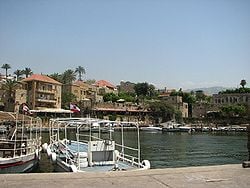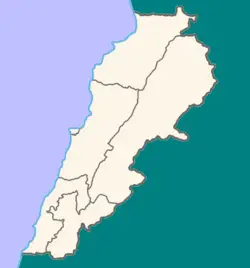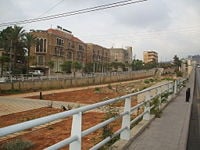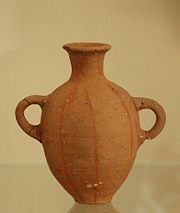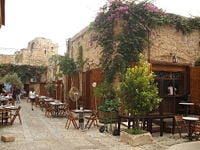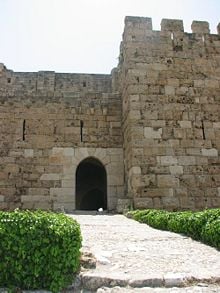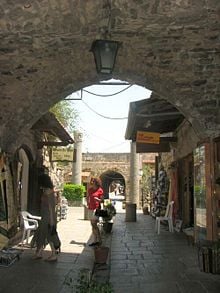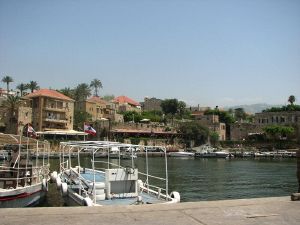Difference between revisions of "Byblos" - New World Encyclopedia
Mary Anglin (talk | contribs) (end matter format) |
Rosie Tanabe (talk | contribs) |
||
| (31 intermediate revisions by 4 users not shown) | |||
| Line 1: | Line 1: | ||
| − | {{Images OK}} | + | {{Images OK}}{{Submitted}}{{Approved}}{{copyedited}} |
| − | {{Infobox | + | {{Infobox Settlement |
| − | | | + | | name = Byblos |
| − | |image_skyline | + | | native_name = |
| − | | | + | | native_name_lang = ara<!-- ISO 639-2 code: "fr" for French, "ara" for Arabic —> |
| − | | | + | | settlement_type = City |
| − | | | + | | image_skyline = ByblosPort.jpg |
| − | | | + | | image_alt = |
| − | | | + | | image_caption = Byblos Port |
| − | | | + | | pushpin_map = Lebanon |
| − | | | + | | pushpin_label_position = |
| − | | | + | | pushpin_map_alt = Map showing the location of Byblos within Lebanon |
| − | | | + | | pushpin_map_caption = Location within Lebanon |
| − | | | + | | latd = 34|latm = 07|latNS = N |
| − | | | + | | longd = 35|longm = 39|longEW = E |
| − | | | + | | coordinates_type = type:city |
| − | | | + | | coordinates_display = inline,title |
| − | | | + | | coordinates_footnotes = |
| + | | subdivision_type = [[List of sovereign states|Country]] | ||
| + | | subdivision_name = {{flagcountry|Lebanon}} | ||
| + | | subdivision_type1 = [[Governorates of Lebanon|Governorate]] | ||
| + | | subdivision_name1 = [[Mount Lebanon Governorate]] | ||
| + | | subdivision_type2 = [[Districts of Lebanon|District]] | ||
| + | | subdivision_name2 = [[Jbeil District]] | ||
| + | | established_title = <!-- Founded —> | ||
| + | | established_date = | ||
| + | | founder = | ||
| + | | leader_party = | ||
| + | | leader_title = | ||
| + | | leader_name = | ||
| + | | area_total_km2 = 5 | ||
| + | | area_metro_km2 = 17 | ||
| + | | population_total = 40000 | ||
| + | | population_metro = 100000 | ||
| + | | population_note = | ||
| + | | timezone1 = [[Eastern European Time|EET]] | ||
| + | | utc_offset1 = +2 | ||
| + | | timezone1_DST = [[Eastern European Summer Time|EEST]] | ||
| + | | utc_offset1_DST = +3 | ||
| + | | postal_code_type = Postal code | ||
| + | | postal_code = | ||
| + | | area_code_type = [[Telephone numbers in Lebanon|Dialing code]] | ||
| + | | area_code = +961 | ||
| + | | footnotes = | ||
| + | | website = | ||
}} | }} | ||
| − | |||
| − | |||
| − | |||
| − | |||
| − | |||
| − | |||
| − | |||
| − | |||
| − | |||
| − | |||
| − | |||
| − | |||
| − | |||
| − | It is mentioned in the [[Bible]] in {{bibleverse|1|Kings|5:18|HE}}, referring to the nationality of the builders of [[Temple of Jerusalem|Solomon's Temple]], and also in Ezekiel 27:9, referring to the riches of [[Tyre, Lebanon|Tyre]]. | + | '''Byblos''' '''(Βύβλος)'''is the [[Greek language|Greek]] name of the [[Phoenicia]]n [[city]] '''Gebal''' (earlier '''Gubla'''). The ancient city on the coast of the [[Mediterranean Sea]] served as the principal harbor for the export of [[cedar]] and other valuable woods to [[Egypt]], which aided its development into a great trading center. The [[archaeology|archaeological]] site, adjacent to the present-day city of Jbail, is about 20 miles (30 km) north of the modern city of [[Beirut]], [[Lebanon]]. |
| + | |||
| + | Byblos is believed to have been founded around 5000 B.C.E., and according to fragments attributed to the semi-legendary pre-[[Troy|Trojan war]] Phoenician historian Sanchuniathon, it was built by [[Cronus]] as the first city in Phoenicia. Today it is believed by many to be the oldest continuously inhabited city in the world. | ||
| + | |||
| + | It is mentioned in the [[Bible]] in {{bibleverse|1|Kings|5:18|HE}}, referring to the nationality of the builders of [[Temple of Jerusalem|Solomon's Temple]], and also in [[Ezekiel]] 27:9, referring to the riches of [[Tyre, Lebanon|Tyre]]. | ||
| + | {{toc}} | ||
| + | |||
| + | In 1984 [[UNESCO]] inscribed Byblos as a cultural [[World Heritage Site]], recognizing the historic value of the ruins of many successive civilizations found there. It has been closely linked to the legends and history of the [[Mediterranean basin|Mediterranean]] region for thousands of years, and is directly associated with the history and diffusion of the Phoenician alphabet. | ||
==History== | ==History== | ||
| − | The Phoenician city of Gebal was named ''Byblos'' by the Greeks, because it was through Gebal that ''Bύβλος'' (''bublos'' | + | The [[Phoenician Civilization|Phoenician]] city of Gebal was named ''Byblos'' by the Greeks, because it was through Gebal that ''Bύβλος'' (''bublos;'' Egyptian [[papyrus]]) was imported into [[Ancient Greece|Greece]]. The present-day city is known by the Arabic name ''Jubayl'' or ''Jbeil'' (جبيل), a direct descendant of the [[Canaanite]] name. |
| − | Byblos ([[Greek language|Greek]]) or Gebal ([[Phoenician]]) is located on the [[Mediterranean]] coast of present-day [[Lebanon]], about 26 miles (42 km) north of [[Beirut]]. It is attractive to [[archaeology|archaeologist]]s because of the successive layers of debris resulting from centuries of human habitation. | + | Byblos ([[Greek language|Greek]]) or Gebal ([[Phoenician]]) is located on the [[Mediterranean Sea|Mediterranean]] coast of present-day [[Lebanon]], about 26 miles (42 km) north of [[Beirut]]. It is attractive to [[archaeology|archaeologist]]s because of the successive layers of debris resulting from centuries of human habitation. |
| − | The site first appears to have been settled during the [[Neolithic]] period, approximately | + | The site first appears to have been settled during the [[Neolithic]] period, approximately 5,000 B.C.E. Neolithic remains of some buildings can be observed at the site. According to the writer Philo of Byblos (quoting Sanchuniathon, and quoted in [[Eusebius]]), Byblos had the reputation of being the oldest city in the world, founded by the [[myth|mythological]] [[Cronus]],<ref>''Internet Sacred Text Archive,'' [http://www.sacred-texts.com/cla/af/af01.htm The Theology Of The Phoenicians: From Sanchoniatho.] Retrieved February 4, 2009.</ref> and was also where [[Thoth]] invented [[writing]], but there has not been concrete proof that it is the oldest city in the world. During the third millennium B.C.E., the first signs of a [[town]] can be observed, with the remains of well-built houses of uniform size. This was the period when the Phoenician civilization began to develop, and archaeologists have recovered [[ancient Egypt|Egyptian]]-made artifacts dated as early as the fourth dynasty of Egypt. |
| − | 5,000 | ||
| − | The growing city was evidently a wealthy one, and seems to have been an ally of Egypt for many centuries. The [[Amarna letters|Amarna tablets]] include 60 letters from Rib-Hadda and his successor Ili-Rapih, rulers of Byblos circa 1350 | + | The growing city was evidently a wealthy one, and seems to have been an ally of Egypt for many centuries. The [[Amarna letters|Amarna tablets]] include 60 letters from Rib-Hadda and his successor Ili-Rapih, rulers of Byblos circa 1350 B.C.E., to the Egyptian government. These deal with the conquest of neighboring city-states by the Hapiru. Objects have been found at Byblos naming the 13th dynasty Egyptian king [[Neferhotep I]], and the rulers of Byblos maintained close relationships with the New Kingdom [[pharaoh]]s of [[Ancient Egypt]]. |
| − | Archaeological evidence at Byblos, dating back to around 1200 | + | Archaeological evidence at Byblos, dating back to around 1200 B.C.E., shows existence of a Phoenician alphabetic script of twenty-two characters; an important example of this script is the [[sarcophagus]] of king [[Ahiram]]. The use of the alphabet was spread by Phoenician merchants through their maritime trade into parts of [[North Africa]] and [[Europe]]. One of the most important monuments of this period is the temple of [[Resheph]], a [[Canaan]]ite war god, but this had fallen into ruins by the time of Alexander. |
| − | In the [[Assyria]]n period, Sibittibaal of Byblos became tributary to Tiglath-pileser III in 738 | + | In the [[Assyria]]n period, Sibittibaal of Byblos became tributary to Tiglath-pileser III in 738 B.C.E., and in 701 B.C.E., when [[Sennacherib]] conquered all Phoenicia, the king of Byblos was Urumilki. Byblos was also subject to Assyrian kings Esarhaddon (r.681-669 B.C.E.) and Ashurbanipal (r.668-627 B.C.E.), under its own kings Milkiasaph and Yehawmelek. |
| − | In the [[Persia]]n period (538-332 | + | In the [[Persia]]n period (538-332 B.C.E.), Byblos was the fourth of four Phoenician vassal kingdoms established by the Persians; the first three being [[Sidon]], [[Tyre, Lebanon|Tyre]], and [[Arwad]]. |
| − | Hellenistic rule came with the arrival of [[Alexander the Great]] in the area in 332 | + | [[Hellenism|Hellenistic]] rule came with the arrival of [[Alexander the Great]] in the area in 332 B.C.E. [[Currency|Coinage]] was in use, and there is abundant evidence of continued trade with other [[Mediterranean basin|Mediterranean]] countries. |
| − | During the [[Ancient Rome|Greco-Roman]] period, the temple of Resheph was elaborately rebuilt, and the city, though smaller than its neighbors such as Tyre and Sidon, was a center for the cult of [[Adonis]]. In the third century, a small but impressive [[theater]] was constructed. | + | During the [[Ancient Rome|Greco-Roman]] period, the temple of Resheph was elaborately rebuilt, and the city, though smaller than its neighbors such as Tyre and Sidon, was a center for the cult of [[Adonis]]. In the third century, a small but impressive [[theater]] was constructed. With the rise of [[Christianity]], a [[bishop]]'s seat was established in Byblos, and the town grew rapidly. Although a [[Persia|Persian]] colony is known to have been established in the region following the [[Islam|Muslim]] conquest of 636, there is little archaeological evidence for it. [[Trade]] with [[Europe]] effectively dried up, and it was not until the coming of the [[Crusades|First Crusade]] in 1098 that prosperity returned to Byblos. |
| − | Byblos, under the name of Gibelet or Giblet, was an important military base in the | + | Byblos, under the name of Gibelet or Giblet, was an important [[military]] base in the Crusader [[Kingdom of Jerusalem]] in the eleventh and twelfth centuries, and the remains of its Crusader [[castle]] are among the most impressive architectural structures now visible at its center. The town was taken by [[Saladin]] in 1187, re-taken by the Crusaders, and eventually conquered by Baibars in 1266. Its fortifications were subsequently restored. From 1516 until 1918, the town and the whole region were part of the [[Ottoman Empire]]. Byblos and all of [[Lebanon]] was placed under [[France|French]] Mandate from 1920 until 1943, when Lebanon achieved independence. |
<center> | <center> | ||
{| | {| | ||
| Line 62: | Line 82: | ||
[[Image:ByblosStreet.jpg|thumb|200px|Byblos, Lebanon]] | [[Image:ByblosStreet.jpg|thumb|200px|Byblos, Lebanon]] | ||
| valign="top"| | | valign="top"| | ||
| − | [[Image:Jug Byblos Louvre AO14707.jpg|thumb|180px|Terracotta jug from Byblos (now in the Louvre), Late Bronze Age (1600-1200 | + | [[Image:Jug Byblos Louvre AO14707.jpg|thumb|180px|Terracotta jug from Byblos (now in the Louvre), Late Bronze Age (1600-1200 B.C.E.)]] |
| valign="top"| | | valign="top"| | ||
[[Image:ByblosSouk.jpg|thumb|200px|Byblos, Lebanon]] | [[Image:ByblosSouk.jpg|thumb|200px|Byblos, Lebanon]] | ||
| Line 68: | Line 88: | ||
|} | |} | ||
</center> | </center> | ||
| − | + | ==Places of interest== | |
| − | == | ||
| − | |||
| − | |||
| − | |||
[[Image:Byblos Castle.jpg|thumb|right|220px|Crusader fort]] | [[Image:Byblos Castle.jpg|thumb|right|220px|Crusader fort]] | ||
[[Image:Byblos Historic Quarter.jpg|thumb|220px|Byblos historic quarter]] | [[Image:Byblos Historic Quarter.jpg|thumb|220px|Byblos historic quarter]] | ||
*'''Ancient Phoenician Temples''' | *'''Ancient Phoenician Temples''' | ||
| − | In the archaeological site of Byblos there are the remains of the '''Great Temple''' (also known as the L-shaped temple) built in 2700 | + | In the archaeological site of Byblos there are the remains of the '''Great Temple''' (also known as the L-shaped temple) built in 2700 B.C.E., '''Temple of Baalat Gebal''' built in 2700 B.C.E., and '''Temple of the Obelisks''' built around 1600 B.C.E. The Phoenician royal necropolis has [[King Hiram]]'s [[sarcophagus]], which bears one of the oldest [[alphabet]]ic inscriptions yet discovered anywhere in the world. |
| − | *'''Byblos Castle | + | *'''Byblos Castle''' |
| − | Byblos Castle was built by the [[Crusades|Crusaders]] in the | + | Byblos Castle was built by the [[Crusades|Crusaders]] in the twelfth century from indigenous [[limestone]] and the remains of [[Rome|Roman]] structures. The finished structure was surrounded by a moat. [[Saladin]] captured the town and castle in 1188 and dismantled the walls in 1190. Later, the Crusaders recaptured Byblos and rebuilt the ramifications of the castle in 1197. It is located in the archaeological site near the port. |
*'''Medieval City Wall''' | *'''Medieval City Wall''' | ||
| Line 86: | Line 102: | ||
*'''Byblos Wax Museum''' | *'''Byblos Wax Museum''' | ||
| − | This museum displays wax statues of characters from [[Phoenicia]]n times to current days | + | This [[museum]] displays wax statues of characters from [[Phoenicia]]n times to current days. |
*'''St. John the Baptist Church''' | *'''St. John the Baptist Church''' | ||
| − | Work on the church started during the Crusades in 1150. It was damaged during an [[earthquake]] in the | + | Work on the church started during the Crusades in 1150. It was damaged during an [[earthquake]] in the twelfth century and also during several conflicts. |
*'''Byblos Fossil Museum''' | *'''Byblos Fossil Museum''' | ||
| − | Byblos Fossil Museum has a collection of [[fossil]]ized [[fish]], [[shark]]s, [[eel]], flying fish, and other marine life, some millions of years old. | + | Byblos Fossil Museum has a collection of [[fossil]]ized [[fish]], [[shark]]s, [[eel]]s, flying fish, and other marine life, some millions of years old. |
*'''Historic Quarter and Souks''' | *'''Historic Quarter and Souks''' | ||
| − | In the southeast section of the historic city, near the entrance of the archaeological site, is an old market where tourists can shop for souvenirs and | + | In the southeast section of the historic city, near the entrance of the archaeological site, is an old market where tourists can shop for souvenirs and [[antique]]s or simply stroll along the old cobblestone streets and enjoy the [[architecture]]. |
*'''Byblos International Festival''' | *'''Byblos International Festival''' | ||
This summer music festival is an annual event that takes place in the historic quarter. | This summer music festival is an annual event that takes place in the historic quarter. | ||
| + | |||
*'''Egyptian Temples''' | *'''Egyptian Temples''' | ||
| − | The earliest date back to the fourth | + | The earliest date back to the fourth millennium. |
| + | |||
*'''Roman amphitheater''' | *'''Roman amphitheater''' | ||
==Looking to the future== | ==Looking to the future== | ||
[[Image:ByblosPort.jpg|thumb|Byblos Port, perhaps the oldest port in the world, is more than 5,000 years old]] | [[Image:ByblosPort.jpg|thumb|Byblos Port, perhaps the oldest port in the world, is more than 5,000 years old]] | ||
| − | Today, Byblos (Jbeil) is a modern city. It remains one of Lebanon's biggest [[tourism|tourist]] attractions, mainly because of its rich history and scenic [[mountain]]s overlooking the [[Mediterranean]]. Most of the people of Byblos are [[Maronite Church|Maronite Catholics]]. There are also some | + | Today, Byblos (Jbeil) is a modern city. It remains one of [[Lebanon]]'s biggest [[tourism|tourist]] attractions, mainly because of its rich history and scenic [[mountain]]s overlooking the [[Mediterranean]]. Most of the people of Byblos are [[Maronite Church|Maronite Catholics]]. There are also some Shi'ite [[Muslim]]s, whose ancestors escaped expulsion by the [[Seljuq dynasty|Seljuk Turks]] in the Middle Ages. The city of Bint Jbeil ("daughter of Jbeil") in southern Lebanon was founded by those displaced Shi'ites. Byblos has three representatives in the Parliament of Lebanon: Two Maronites and one Shi'ite. |
| + | |||
| + | Byblos is the site of the professional campus of the Lebanese American University. The Byblos Campus is the home of the professional schools, including the Medical School, the Engineering School, the Pharmacy School, in addition to the School of Arts and Sciences and the School of Business. | ||
| − | Tourism was once a very important contributor to Lebanon's economy, accounting for almost 20 percent of the GDP in the two decades before the start of the civil war. Since the end of the war, the sector has managed to revive somewhat, but tourism has yet to return to its pre-war levels. Tourism in 1999 accounted for 9 percent of the GDP. In 2001, the tourism sector was one of the fastest growing sectors of the economy, with the number of tourists visiting Lebanon between 1996 and 2000 growing at the rate of 14 percent annually.<ref name="NE"> | + | Tourism was once a very important contributor to Lebanon's economy, accounting for almost 20 percent of the GDP in the two decades before the start of the [[civil war]]. Since the end of the war, the sector has managed to revive somewhat, but tourism has yet to return to its pre-war levels. Tourism in 1999 accounted for 9 percent of the GDP. In 2001, the tourism sector was one of the fastest growing sectors of the economy, with the number of tourists visiting Lebanon between 1996 and 2000 growing at the rate of 14 percent annually.<ref name="NE">''National Economies Encyclopedia,'' [http://www.nationsencyclopedia.com/economies/Asia-and-the-Pacific/Lebanon.html Lebanon.] Retrieved February 4, 2009.</ref> In 2003, the tourism industry contributed $6.374 billion to the Lebanese economy, and in 2005 the receipts per capita reached $1,433.<ref name="WTO2">''World Tourism Organization,'' [http://unwto.org/facts/eng/pdf/indicators/new/ITR05_ME_US$.pdf Tourism Market Trends, 2006.] Retrieved February 4, 2009.</ref> In 2006, the Ministry of Tourism counted 373,037 admissions to the country's main ministry-run tourist sites.<ref name=lcas>''Lebanon Central Administration for Statistics,'' Lebanese Republic.</ref> |
| − | But the numbers for Byblos have dropped drastically, from 59,337 in 2004 to 36,341 in 2006, the latest year for which statistics are available.<ref | + | But the numbers for Byblos have dropped drastically, from 59,337 in 2004 to 36,341 in 2006, the latest year for which statistics are available.<ref name=lcas/> This can probably be attributed to the sectarian violence plaguing Lebanon, as well as the recent global economic crisis. |
== Notes == | == Notes == | ||
| Line 115: | Line 135: | ||
==References== | ==References== | ||
| − | * Jidejian, Nina. 1968. ''Byblos | + | * Jidejian, Nina. 1968. ''Byblos Through the Ages''. Beirut: Dar el-Machreq Publishers. {{OCLC|7630}}. |
| − | * ''MiddleEast.com''. [http://www.middleeast.com/byblos.htm Byblos] Retrieved February 4, 2009. | + | * ''MiddleEast.com''. [http://www.middleeast.com/byblos.htm Byblos.] Retrieved February 4, 2009. |
| − | * Nibbi, Alessandra. 1985. ''Ancient Byblos | + | * Nibbi, Alessandra. 1985. ''Ancient Byblos Reconsidered''. Oxford: DE Publications. ISBN 9780951070406. |
| − | * Thiollet, Jean-Pierre. 2005. ''Je m'appelle Byblos''. Histoire & découvertes. Milon La Chapelle: Éditions H & D. ISBN 2914266049 | + | * Thiollet, Jean-Pierre. 2005. ''Je m'appelle Byblos''. Histoire & découvertes. Milon La Chapelle: Éditions H & D. ISBN 2914266049. |
== External links == | == External links == | ||
| − | * [http://tyros.leb.net/byblos Lebanon, the Cedars' Land: Byblos] | + | All links retrieved November 24, 2023. |
| + | * [http://tyros.leb.net/byblos Lebanon, the Cedars' Land: Byblos] | ||
[[Category:Geography]] | [[Category:Geography]] | ||
[[Category:Middle East]] | [[Category:Middle East]] | ||
[[Category:Cities]] | [[Category:Cities]] | ||
| + | [[Category:World Heritage Sites]] | ||
{{Credit|265571319}} | {{Credit|265571319}} | ||
Latest revision as of 19:08, 24 November 2023
| Byblos | |
| — City — | |
| Byblos Port | |
| Location within Lebanon | |
| Coordinates: 34°07′N 35°39′E | |
|---|---|
| Country | |
| Governorate | Mount Lebanon Governorate |
| District | Jbeil District |
| Area | |
| - City | 5 km² (1.9 sq mi) |
| - Metro | 17 km² (6.6 sq mi) |
| Population | |
| - City | 40,000 |
| - Metro | 100,000 |
| Postal code | |
| Area code(s) | +961 |
Byblos (Βύβλος)is the Greek name of the Phoenician city Gebal (earlier Gubla). The ancient city on the coast of the Mediterranean Sea served as the principal harbor for the export of cedar and other valuable woods to Egypt, which aided its development into a great trading center. The archaeological site, adjacent to the present-day city of Jbail, is about 20 miles (30 km) north of the modern city of Beirut, Lebanon.
Byblos is believed to have been founded around 5000 B.C.E., and according to fragments attributed to the semi-legendary pre-Trojan war Phoenician historian Sanchuniathon, it was built by Cronus as the first city in Phoenicia. Today it is believed by many to be the oldest continuously inhabited city in the world.
It is mentioned in the Bible in 1 Kings 5:18, referring to the nationality of the builders of Solomon's Temple, and also in Ezekiel 27:9, referring to the riches of Tyre.
In 1984 UNESCO inscribed Byblos as a cultural World Heritage Site, recognizing the historic value of the ruins of many successive civilizations found there. It has been closely linked to the legends and history of the Mediterranean region for thousands of years, and is directly associated with the history and diffusion of the Phoenician alphabet.
History
The Phoenician city of Gebal was named Byblos by the Greeks, because it was through Gebal that Bύβλος (bublos; Egyptian papyrus) was imported into Greece. The present-day city is known by the Arabic name Jubayl or Jbeil (جبيل), a direct descendant of the Canaanite name.
Byblos (Greek) or Gebal (Phoenician) is located on the Mediterranean coast of present-day Lebanon, about 26 miles (42 km) north of Beirut. It is attractive to archaeologists because of the successive layers of debris resulting from centuries of human habitation.
The site first appears to have been settled during the Neolithic period, approximately 5,000 B.C.E. Neolithic remains of some buildings can be observed at the site. According to the writer Philo of Byblos (quoting Sanchuniathon, and quoted in Eusebius), Byblos had the reputation of being the oldest city in the world, founded by the mythological Cronus,[1] and was also where Thoth invented writing, but there has not been concrete proof that it is the oldest city in the world. During the third millennium B.C.E., the first signs of a town can be observed, with the remains of well-built houses of uniform size. This was the period when the Phoenician civilization began to develop, and archaeologists have recovered Egyptian-made artifacts dated as early as the fourth dynasty of Egypt.
The growing city was evidently a wealthy one, and seems to have been an ally of Egypt for many centuries. The Amarna tablets include 60 letters from Rib-Hadda and his successor Ili-Rapih, rulers of Byblos circa 1350 B.C.E., to the Egyptian government. These deal with the conquest of neighboring city-states by the Hapiru. Objects have been found at Byblos naming the 13th dynasty Egyptian king Neferhotep I, and the rulers of Byblos maintained close relationships with the New Kingdom pharaohs of Ancient Egypt.
Archaeological evidence at Byblos, dating back to around 1200 B.C.E., shows existence of a Phoenician alphabetic script of twenty-two characters; an important example of this script is the sarcophagus of king Ahiram. The use of the alphabet was spread by Phoenician merchants through their maritime trade into parts of North Africa and Europe. One of the most important monuments of this period is the temple of Resheph, a Canaanite war god, but this had fallen into ruins by the time of Alexander.
In the Assyrian period, Sibittibaal of Byblos became tributary to Tiglath-pileser III in 738 B.C.E., and in 701 B.C.E., when Sennacherib conquered all Phoenicia, the king of Byblos was Urumilki. Byblos was also subject to Assyrian kings Esarhaddon (r.681-669 B.C.E.) and Ashurbanipal (r.668-627 B.C.E.), under its own kings Milkiasaph and Yehawmelek.
In the Persian period (538-332 B.C.E.), Byblos was the fourth of four Phoenician vassal kingdoms established by the Persians; the first three being Sidon, Tyre, and Arwad.
Hellenistic rule came with the arrival of Alexander the Great in the area in 332 B.C.E. Coinage was in use, and there is abundant evidence of continued trade with other Mediterranean countries.
During the Greco-Roman period, the temple of Resheph was elaborately rebuilt, and the city, though smaller than its neighbors such as Tyre and Sidon, was a center for the cult of Adonis. In the third century, a small but impressive theater was constructed. With the rise of Christianity, a bishop's seat was established in Byblos, and the town grew rapidly. Although a Persian colony is known to have been established in the region following the Muslim conquest of 636, there is little archaeological evidence for it. Trade with Europe effectively dried up, and it was not until the coming of the First Crusade in 1098 that prosperity returned to Byblos.
Byblos, under the name of Gibelet or Giblet, was an important military base in the Crusader Kingdom of Jerusalem in the eleventh and twelfth centuries, and the remains of its Crusader castle are among the most impressive architectural structures now visible at its center. The town was taken by Saladin in 1187, re-taken by the Crusaders, and eventually conquered by Baibars in 1266. Its fortifications were subsequently restored. From 1516 until 1918, the town and the whole region were part of the Ottoman Empire. Byblos and all of Lebanon was placed under French Mandate from 1920 until 1943, when Lebanon achieved independence.
Places of interest
- Ancient Phoenician Temples
In the archaeological site of Byblos there are the remains of the Great Temple (also known as the L-shaped temple) built in 2700 B.C.E., Temple of Baalat Gebal built in 2700 B.C.E., and Temple of the Obelisks built around 1600 B.C.E. The Phoenician royal necropolis has King Hiram's sarcophagus, which bears one of the oldest alphabetic inscriptions yet discovered anywhere in the world.
- Byblos Castle
Byblos Castle was built by the Crusaders in the twelfth century from indigenous limestone and the remains of Roman structures. The finished structure was surrounded by a moat. Saladin captured the town and castle in 1188 and dismantled the walls in 1190. Later, the Crusaders recaptured Byblos and rebuilt the ramifications of the castle in 1197. It is located in the archaeological site near the port.
- Medieval City Wall
The old medieval part of Byblos is surrounded by walls running about 270 m from east to west and 200 m from north to south
- Byblos Wax Museum
This museum displays wax statues of characters from Phoenician times to current days.
- St. John the Baptist Church
Work on the church started during the Crusades in 1150. It was damaged during an earthquake in the twelfth century and also during several conflicts.
- Byblos Fossil Museum
Byblos Fossil Museum has a collection of fossilized fish, sharks, eels, flying fish, and other marine life, some millions of years old.
- Historic Quarter and Souks
In the southeast section of the historic city, near the entrance of the archaeological site, is an old market where tourists can shop for souvenirs and antiques or simply stroll along the old cobblestone streets and enjoy the architecture.
- Byblos International Festival
This summer music festival is an annual event that takes place in the historic quarter.
- Egyptian Temples
The earliest date back to the fourth millennium.
- Roman amphitheater
Looking to the future
Today, Byblos (Jbeil) is a modern city. It remains one of Lebanon's biggest tourist attractions, mainly because of its rich history and scenic mountains overlooking the Mediterranean. Most of the people of Byblos are Maronite Catholics. There are also some Shi'ite Muslims, whose ancestors escaped expulsion by the Seljuk Turks in the Middle Ages. The city of Bint Jbeil ("daughter of Jbeil") in southern Lebanon was founded by those displaced Shi'ites. Byblos has three representatives in the Parliament of Lebanon: Two Maronites and one Shi'ite.
Byblos is the site of the professional campus of the Lebanese American University. The Byblos Campus is the home of the professional schools, including the Medical School, the Engineering School, the Pharmacy School, in addition to the School of Arts and Sciences and the School of Business.
Tourism was once a very important contributor to Lebanon's economy, accounting for almost 20 percent of the GDP in the two decades before the start of the civil war. Since the end of the war, the sector has managed to revive somewhat, but tourism has yet to return to its pre-war levels. Tourism in 1999 accounted for 9 percent of the GDP. In 2001, the tourism sector was one of the fastest growing sectors of the economy, with the number of tourists visiting Lebanon between 1996 and 2000 growing at the rate of 14 percent annually.[2] In 2003, the tourism industry contributed $6.374 billion to the Lebanese economy, and in 2005 the receipts per capita reached $1,433.[3] In 2006, the Ministry of Tourism counted 373,037 admissions to the country's main ministry-run tourist sites.[4]
But the numbers for Byblos have dropped drastically, from 59,337 in 2004 to 36,341 in 2006, the latest year for which statistics are available.[4] This can probably be attributed to the sectarian violence plaguing Lebanon, as well as the recent global economic crisis.
Notes
- ↑ Internet Sacred Text Archive, The Theology Of The Phoenicians: From Sanchoniatho. Retrieved February 4, 2009.
- ↑ National Economies Encyclopedia, Lebanon. Retrieved February 4, 2009.
- ↑ World Tourism Organization, Tourism Market Trends, 2006. Retrieved February 4, 2009.
- ↑ 4.0 4.1 Lebanon Central Administration for Statistics, Lebanese Republic.
ReferencesISBN links support NWE through referral fees
- Jidejian, Nina. 1968. Byblos Through the Ages. Beirut: Dar el-Machreq Publishers. OCLC 7630.
- MiddleEast.com. Byblos. Retrieved February 4, 2009.
- Nibbi, Alessandra. 1985. Ancient Byblos Reconsidered. Oxford: DE Publications. ISBN 9780951070406.
- Thiollet, Jean-Pierre. 2005. Je m'appelle Byblos. Histoire & découvertes. Milon La Chapelle: Éditions H & D. ISBN 2914266049.
External links
All links retrieved November 24, 2023.
Credits
New World Encyclopedia writers and editors rewrote and completed the Wikipedia article in accordance with New World Encyclopedia standards. This article abides by terms of the Creative Commons CC-by-sa 3.0 License (CC-by-sa), which may be used and disseminated with proper attribution. Credit is due under the terms of this license that can reference both the New World Encyclopedia contributors and the selfless volunteer contributors of the Wikimedia Foundation. To cite this article click here for a list of acceptable citing formats.The history of earlier contributions by wikipedians is accessible to researchers here:
The history of this article since it was imported to New World Encyclopedia:
Note: Some restrictions may apply to use of individual images which are separately licensed.
